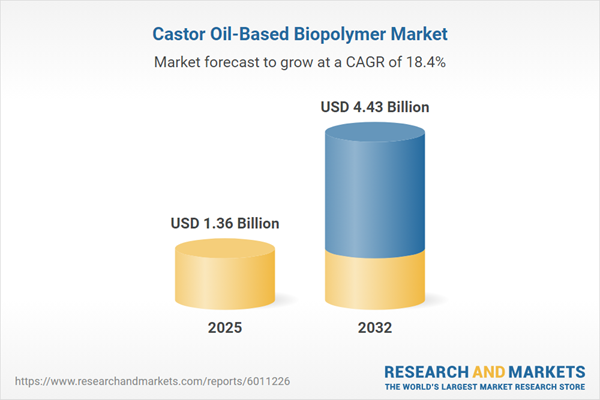Speak directly to the analyst to clarify any post sales queries you may have.
Amid intensified sustainability mandates, senior executives are increasingly prioritizing castor oil-based biopolymers as a solution to reinforce supply chain resilience while meeting growing regulatory and operational demands. The castor oil-based biopolymer market is rapidly evolving, presenting opportunities for forward-looking organizations to enhance traceability and efficiency across procurement and manufacturing.
Market Snapshot: Castor Oil-Based Biopolymer Market
The global castor oil-based biopolymer market is on a strong upward trajectory, expanding from USD 1.14 billion in 2024 to USD 1.36 billion by 2025, with projected growth to USD 4.43 billion by 2032 at an 18.39% CAGR. This progress underscores a marked industry commitment to renewable feedstocks and environmentally compliant solutions. Castor oil's distinctive hydroxy fatty acid profile supports the development of advanced biopolymers that are increasingly favored for high-performance applications. Key sectors such as healthcare, packaging, and manufacturing are accelerating adoption to secure operational reliability, facilitate regulatory alignment, and address stakeholder expectations around ESG transparency and sustainable supply chains.
Scope & Segmentation
- Polymer Types: Includes aliphatic and semi-aromatic polyamides for robust mechanical properties, as well as aliphatic and aromatic polyesters. Options also encompass polyester and polyether polyurethanes engineered to meet diverse sector requirements.
- Applications: Used in solvent and water-based adhesives, critical automotive components, coatings for both industrial and decorative purposes, medical devices, drug delivery systems, flexible packaging, specialty fibers, and industrial nonwovens.
- End-Use Industries: Targets automotive, construction, healthcare, packaging, and textiles. Each segment leverages castor oil-based biopolymers to achieve lightweighting, improved durability, adherence to regulations, and greater biocompatibility in sensitive applications.
- Processing Technologies: Employs 3D printing for design versatility, blow molding for creating hollow shapes, extrusion for consistent high-volume output, and injection molding to enhance production efficiency and quality.
- Regional Coverage: Market activity spans the Americas, Europe, Middle East, Africa, and Asia-Pacific, enabling adaptation to differing regulatory frameworks and various sustainability targets in each geography.
- Leading Companies: Key producers include Emery Oleochemicals, KLK Oleo Sdn. Bhd., Oleon NV, Croda International Plc, BASF SE, Arkema SA, Vantage Specialty Chemicals LLC, Vertellus Holdings LLC, Allessa GmbH, and Eastman Chemical Company, ensuring both supply reliability and ongoing sector innovation.
Key Takeaways for Decision Makers
- Implementing traceable biopolymers supports alignment with ESG objectives and enhances supply chain transparency across sourcing networks.
- Investment in modern manufacturing, including additive and catalytic techniques, helps accelerate product development and allows rapid shifts to meet diverse industry needs.
- Custom polymer formulations are facilitating the evolution of sectors such as automotive and healthcare, providing lighter and highly functional materials adaptable to regulatory change.
- Building relationships with local feedstock suppliers and integrating upstream supply chain activities shields operations from raw material shortages and market disruptions.
- Proactively adapting to shifts in regional markets—particularly in Asia-Pacific and North America—enables organizations to stay ahead in procurement and compliance planning.
Tariff Impact on Supply Chains and Cost Structures
Forthcoming changes in tariffs for castor seed oil and related compounds are prompting companies, particularly those operating in the United States, to diversify supplier portfolios and expand domestic production. This approach reduces vulnerability to trade fluctuations, sustains continuity, and increases operational flexibility amid ongoing policy changes affecting market access and pricing structures.
Methodology & Data Sources
This analysis leverages insights from direct interviews with industry experts, scrutiny of regulatory filings, global trade databases, patent reviews, and specialized sector publications. Oversight by an independent advisory panel ensures all projections and models remain tailored to current industry realities for practical, actionable recommendations.
Why This Report Matters
- Offers concise, actionable insights to optimize procurement, navigate tariff environments, and adhere to shifting regulatory requirements in the castor oil-based biopolymer market.
- Supports benchmarking of supply chain strategies, enhancing stability and enabling sustainable sourcing across varied and complex procurement environments.
- Enables data-driven decisions for sourcing, R&D allocation, and investment prioritization to maintain sector competitiveness and foster responsible growth.
Conclusion
Castor oil-based biopolymers provide senior leaders with a strategic pathway to balance sustainability, compliance, and operational efficiency. This report delivers insights designed to inform decisive action amid an evolving global landscape.
Additional Product Information:
- Purchase of this report includes 1 year online access with quarterly updates.
- This report can be updated on request. Please contact our Customer Experience team using the Ask a Question widget on our website.
Table of Contents
3. Executive Summary
4. Market Overview
7. Cumulative Impact of Artificial Intelligence 2025
Companies Mentioned
The companies profiled in this Castor Oil-Based Biopolymer market report include:- Emery Oleochemicals, L.P.
- KLK Oleo Sdn. Bhd.
- Oleon NV
- Croda International PLC
- BASF SE
- Arkema SA
- Vantage Specialty Chemicals, LLC
- Vertellus Holdings LLC
- Allessa GmbH
- Eastman Chemical Company
Table Information
| Report Attribute | Details |
|---|---|
| No. of Pages | 181 |
| Published | November 2025 |
| Forecast Period | 2025 - 2032 |
| Estimated Market Value ( USD | $ 1.36 Billion |
| Forecasted Market Value ( USD | $ 4.43 Billion |
| Compound Annual Growth Rate | 18.3% |
| Regions Covered | Global |
| No. of Companies Mentioned | 11 |









